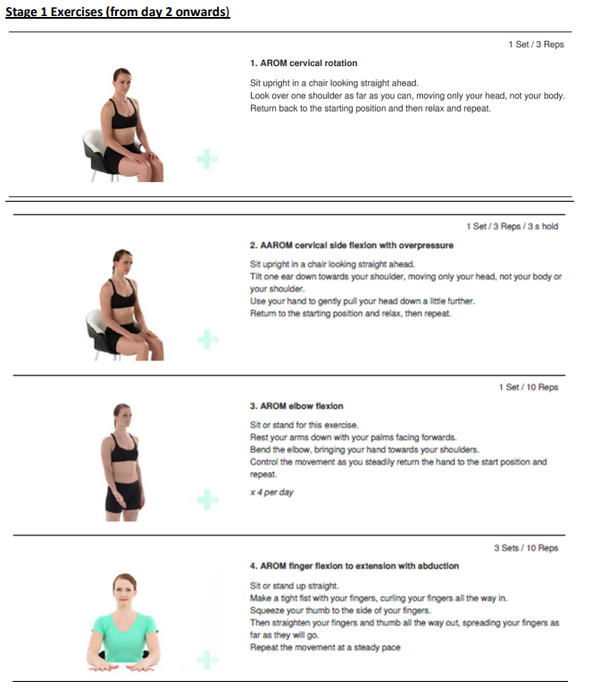Shoulder Injury / Fractured Proximal Humerus
You have been treated for a proximal humerus fracture. This leaflet explains how to look after your arm at home.
What is a proximal humerus fracture?
The shoulder joint is a ball and socket joint. You have been seen because you have broken (fractured) the ball part of the shoulder or the area just below it.

This break usually starts to “glue” together between 4 to 8 weeks following your injury. Once it begins to heal it is important to start to gently move the shoulder to reduce the stiffness.
Your full recovery may take up to two years. After this type of injury, some degree of stiffness is inevitable and you may not be able to fully raise the arm up above your head. The aim is to regain good functional movement to perform your usual daily tasks. You may need some physiotherapy help you in your recovery once the fracture has started to heal.
Sling
You will be given a sling to wear for six weeks. This must be worn 24 hours a day, except for when taking the arm out to wash and regularly exercise the arm.
How do I get dressed?
It is easier to use front button shirts and pull-up trousers with an elastic waistband in the first few weeks. When dressing put the injured arm into sleeves first and when undressing take the un-injured arm out first, followed by the injured arm.
Sleeping
You may find it easier to sleep more upright than usual, using pillows to prop you up in bed or in a reclining armchair. These injuries are usually very sore and you are likely to need to take painkillers, especially in the first two weeks. Take these as advised by your pharmacist or doctor.
Armpit Hygiene
To wash under your arm, lean forward slightly while your arm is out of the sling as if you were doing the elbow straightening exercise. Lean forwards slightly to that your arm hangs slightly away from your body. You should then be able to wash and apply deodorant.
Smoking
Smoking slows down the healing of fractures and may sometimes lead to it not healing at all. For more information on how to stop smoking, please visit this website https://www.nhs.uk/smokefree.
Follow-up appointments
You may be seen back in fracture clinic at one to two weeks following your injury for an x-ray to check the position of the fracture. Sometimes an operation may be needed, at which point an orthopaedic surgeon will discuss this with you at your appointment.
Guidance for day one up until four weeks
- Sling: Wear the sling all the time, only removing it to regularly exercise your arm, and to shower.
- Exercise: During the first four weeks it is important not to actively move your shoulder joint to allow healing to take place. You must regularly move the neck, elbow, wrist as you may find that the joints around your arm become slightly swollen, particularly if you do not move it. To prevent this from happening you should do the following exercises from day two. Avoid very painful movements and exercise within the limits of pain. You may need to take your painkillers, as advised by your doctor.

Guidance from 4 to 6 weeks
- Sling: Unless you are told otherwise, from four weeks you can start to wean out of the sling completely. Initially you may need to still wear it at times just for comfort, and if you’re in a busy environment such as on public transport. You should have stopped using your sling completely by about eight weeks.
- Exercise: You can start to move your affected shoulder with the assistance of your uninjured arm from 4 weeks. You should try to do each exercise 10 times and then repeat all the exercises 4 to 5 times a day. You may need physiotherapy at this point.
Avoid excessively painful movements (more than 4 / 10 pain score)
Avoid forcing the arm, and exercise within limits of a tolerable pain. You may need to take painkillers, as prescribed by your doctor.


Stage 3 Exercises (from week 6)
Start from week 6, or once you can do stage 2 exercises comfortably with only some discomfort and when you have regained more than 2/3 of your full movement. At this point you can begin to return to your usual daily tasks, but start with lighter tasks.

How to get in touch
- If you are still in pain despite this please also discuss your follow up care with your GP. If you are very concerned, then you may attend the A and E department however at this time we advise that you do this only if you are very concerned and it is an emergency. The A and E department will be occupied with patients requiring lifesaving treatment and it is important to allow these patients to access the care they need.
- You can call your physio on 020 3315 8404 or email caw-tr.therapies@nhs.net.

